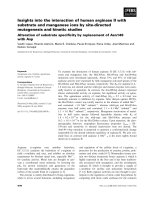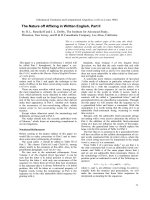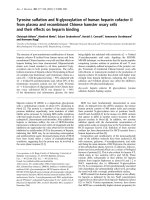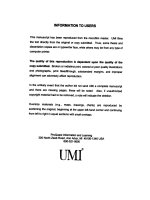PART II POVERTY INEQUALITY AND REDISTR
Bạn đang xem bản rút gọn của tài liệu. Xem và tải ngay bản đầy đủ của tài liệu tại đây (273.29 KB, 21 trang )
PART II:
GOVERNMENT AND THE
PROBLEM OF EQUITY
Poverty, Inequality and
Redistribution policy
HOANG PHU LY, FACULTY OF
INTERNATIONAL ECONOMICS
1
CHAPTER 1
INEQUALITY
HOANG PHU LY, FACULTY OF
INTERNATIONAL ECONOMICS
2
II. Inequality
HOANG PHU LY, FACULTY OF
INTERNATIONAL ECONOMICS
3
1
1. Measuring Inequality
Measuring Inequality
Size distributions
Lorenz curves and Gini coefficients
Functional distributions
HOANG PHU LY, FACULTY OF
INTERNATIONAL ECONOMICS
4
Measuring Inequality
Lorenz curves
Arrange population according to the share of income
they receive, from lowest to highest.
Calculate cumulative percentages (the lowest 5%, the
lowest 45%, etc.)
Plot the cumulative percentage of households against
the cumulative percentage of the income they earn.
HOANG PHU LY, FACULTY OF
INTERNATIONAL ECONOMICS
5
The Lorenz Curve
HOANG PHU LY, FACULTY OF
INTERNATIONAL ECONOMICS
6
2
Measuring Inequality and Poverty
Measuring Inequality
Gini coefficients (an aggregate measure of
inequality)
It’s a quantitative measure of how far a society is
from being perfectly equal.
Calculate the area between the perfect-equality curve
and the actual curve.
Divide that area by the total area under the perfectequality curve.
HOANG PHU LY, FACULTY OF
INTERNATIONAL ECONOMICS
7
Estimating the Gini Coefficient
HOANG PHU LY, FACULTY OF
INTERNATIONAL ECONOMICS
8
Measuring Inequality and Poverty
Measuring Inequality
Functional Distributions
What is the income that goes to each kind of
factor of production? That is, what is the labor
share in income? What is the profit-rent-interest
share in income?
HOANG PHU LY, FACULTY OF
INTERNATIONAL ECONOMICS
9
3
Functional Income Distribution in a
Market Economy: An Illustration
According to this theory, incomes
are determined by demand for the
input (and therefore by it’s
marginal productivity) and by its
supply.
Non-market influences (or market
imperfections) are ignored.
HOANG PHU LY, FACULTY OF
INTERNATIONAL ECONOMICS
10
2. Causes of inequality
HOANG PHU LY, FACULTY OF
INTERNATIONAL ECONOMICS
11
2. Causes of inequality
Two features of labor markets contribute to inequality:
Human capital
Discrimination
Human Capital
High-skilled workers have a higher value of marginal
product than low-skilled workers.
Figure (a) on the next slide illustrates the demand for highskilled and low-skilled labor
HOANG PHU LY, FACULTY OF
INTERNATIONAL ECONOMICS
12
4
2 HOW INEQUALITY ARISES
Demand for High-skilled
and low-skilled labor
High-skilled labor has a
higher VMP than low-skilled
labor and a greater demand.
The demand curve for highskilled labor, DH, lies above
the demand curve for lowskilled labor, DL, by the VMP
of skill.
HOANG PHU LY, FACULTY OF
INTERNATIONAL ECONOMICS
13
HOANG PHU LY, FACULTY OF
INTERNATIONAL ECONOMICS
14
2 HOW INEQUALITY ARISES
The Supply of High-Skilled and Low-Skilled
Labor
Skills are costly to acquire, and a worker pays the
cost of acquiring a skill before benefiting from a
higher wage.
Figure (b) on the next slide illustrates the supply
of high-skilled and low-skilled labor
HOANG PHU LY, FACULTY OF
INTERNATIONAL ECONOMICS
15
5
2 HOW INEQUALITY ARISES
High-skilled labor bears the
cost of acquiring skill.
The supply curve of highskilled labor, SH, lies above
the supply curve of low-skilled
labor, SL, by the
compensation for the cost of
acquiring skill.
HOANG PHU LY, FACULTY OF
INTERNATIONAL ECONOMICS
16
HOANG PHU LY, FACULTY OF
INTERNATIONAL ECONOMICS
17
2 HOW INEQUALITY ARISES
Wage rates of High-Skilled and Low-Skilled
Labor
The combined effects of skill on the demand for
and supply of labor generate a higher wage for
high-skilled labor than for low-skilled labor.
Figure (c) on the next slide illustrates the skilled
wage differential.
HOANG PHU LY, FACULTY OF
INTERNATIONAL ECONOMICS
18
6
2 HOW INEQUALITY ARISES
The demand for low-skilled labor,
DL, and the supply of low-skilled
labor, SL, determine the wage rate
of low-skilled labor—in this example
at $10 an hour.
The demand for high-skilled
labor, DH, and the supply of highskilled labor, SH, determine the
wage rate of high-skilled labor—
in this example at $20 an hour.
HOANG PHU LY, FACULTY OF
INTERNATIONAL ECONOMICS
19
HOANG PHU LY, FACULTY OF
INTERNATIONAL ECONOMICS
20
2 HOW INEQUALITY ARISES
Discrimination
Human capital differences explain much of the
income inequality that exists.
Economists are not sure whether (and disagree
about) discrimination adds to income inequality.
One line of argument is that competition prevents
discrimination. But race and sex income
differences do persist.
HOANG PHU LY, FACULTY OF
INTERNATIONAL ECONOMICS
21
7
2 HOW INEQUALITY ARISES
Unequal Ownership of Capital
Inequality arises from saving and bequests.
Two features of bequests make intergenerational
transfers of wealth a source of increased
inequality:
Debts cannot be bequeathed.
Mating is assortative.
HOANG PHU LY, FACULTY OF
INTERNATIONAL ECONOMICS
22
2 HOW INEQUALITY ARISES
Debts Cannot Be Bequeathed
Debts cannot be forced onto other household members.
Because a zero inheritance is the smallest inheritance that
anyone can receive, bequests can only add to future
generations’ wealth and income potential.
Asortative Mating
The tendency for people to marry within their own
socioeconomic class.
Wealth becomes more concentrated.
HOANG PHU LY, FACULTY OF
INTERNATIONAL ECONOMICS
23
CHAPTER 2:
POVERTY
La Pauvreté
HOANG PHU LY, FACULTY OF
INTERNATIONAL ECONOMICS
24
8
1. Measuring Poverty
Poverty is
Lack of income;
Lack of drinking water
Lack of access to health care
Lack of protection against adverse shocks
HOANG PHU LY, FACULTY OF
INTERNATIONAL ECONOMICS
25
Measuring Poverty
Measuring Absolute
Poverty
The Absolute Poverty
Headcount H simply
adds the number of
people whose income is
below an agreed upon
poverty line.
The Headcount index
H/N divides this number
by the population.
HOANG PHU LY, FACULTY OF
INTERNATIONAL ECONOMICS
26
Measuring Poverty
Measuring Absolute Poverty
Total poverty gap
TPG i 1 (Yp Yi )
H
where
Yp is the absolute poverty line
Yi is income of person i
HOANG PHU LY, FACULTY OF
INTERNATIONAL ECONOMICS
27
9
Measuring Poverty
Measuring Absolute Poverty
Average poverty gap
TPG
H
APG
where
H is number of persons under
poverty line
TPG is total poverty gap
HOANG PHU LY, FACULTY OF
INTERNATIONAL ECONOMICS
28
Measuring Poverty
Measuring Absolute Poverty
The Normalized Poverty Gap is the Total Poverty
Gap divided by the product of the poverty line and
the population
NPG
H
i 1
(Y p Yi )
NY p
HOANG PHU LY, FACULTY OF
INTERNATIONAL ECONOMICS
29
Measuring Poverty
Measuring Absolute Poverty
Foster-Greer-Thorbecke measure
1
P
N
Yp Yi
Y
i 1
p
H
If =2, you get a measure that is extremely sensitive
to the depth and severity of poverty.
HOANG PHU LY, FACULTY OF
INTERNATIONAL ECONOMICS
30
10
Policy Options
HOANG PHU LY, FACULTY OF
INTERNATIONAL ECONOMICS
31
The Range of Policy Options:
Some Basic Considerations
Areas of intervention
Change the functional distribution
Give more income to labor and less to capital.
Change asset and skill inequality: the sources of income
inequality.
Land reform; microcredit; basic education
Make taxes more progressive.
Poverty reduction programs: direct transfers or subsidies
for food, education, health, etc.
HOANG PHU LY, FACULTY OF
INTERNATIONAL ECONOMICS
32
The Range of Policy Options:
Some Basic Considerations
Policy options
Changing relative factor prices
Traditional-sector workers have very low incomes
and minimum-wage laws are seldom enforced.
Artificially high modern-sector wages (due to unions
or laws) reduce the growth of the modern sector,
condemning more people to poverty and exclusion.
HOANG PHU LY, FACULTY OF
INTERNATIONAL ECONOMICS
33
11
The Range of Policy Options:
Some Basic Considerations
Policy options
Changing relative factor prices
Market-determined wages (which would be lower) in
the modern sector would increase employment and
incomes for the poor.
Market-determined cost of capital (which would be
higher) would encourage firms to hire workers rather
than buy capital.
HOANG PHU LY, FACULTY OF
INTERNATIONAL ECONOMICS
34
The Range of Policy Options:
Some Basic Considerations
Policy options
Transfer payments and public provision of goods
and services
Make sure it’s targeted to the poor.
Prevent the poor from becoming dependent on it … but
encourage appropriate risk taking.
Discourage switching from work to program.
Avoid resentment by nearly-poor-but-not-enough who
are working.
HOANG PHU LY, FACULTY OF
INTERNATIONAL ECONOMICS
35
The Range of Policy Options: Some
Basic Considerations
The need for a ‘package’ of policies
Eliminate price distortions: more efficiency, more
employment and less poverty
Structural change in asset ownership
Progressive taxes and transfers; safety net
HOANG PHU LY, FACULTY OF
INTERNATIONAL ECONOMICS
36
12
2. Poverty in Vietnam
To see the Pdf file
HOANG PHU LY, FACULTY OF
INTERNATIONAL ECONOMICS
37
Chapter 3
INCOME REDISTRIBUTION
HOANG PHU LY, FACULTY OF
INTERNATIONAL ECONOMICS
38
1. Some theories of redistribution
i.
ii.
iii.
Theory of Utilitarianism
Theory of egalitarianism
The Rawls’ Theory
HOANG PHU LY, FACULTY OF
INTERNATIONAL ECONOMICS
39
13
i. Theory of Utilitarianism
a, Hypothesis
All the people has the same MU function and MU depend
only on the level of revenue
These MU function follow the law of diminishing MU
The total revenue is fix and still stable when there is the
redistribution policy
=> The function of social welfare W = U1 + U2+ Ui +….+ Un
b, Description:
To see the graphic
HOANG PHU LY, FACULTY OF
INTERNATIONAL ECONOMICS
40
MU A
e
MU B
f
g
c
d
O’
O
h
Revenue A
b
a
Revenue B
Lost of A: abcd
Gain of B: abef
Gain of Social welfare: cdef
Conclusion: at which
point there is the
perfect equality?
g: max of social welfare, revenue i = h
HOANG PHU LY, FACULTY OF
INTERNATIONAL ECONOMICS
41
c, Some problems
1st hypo: if people has different MU
functions?
2nd hypo: the law of diminishing MU is true
with the goods, but how about the revenue?
3rd hypo: all programs of redistribution need
at least the administrative cost=> loss of total
revenue
HOANG PHU LY, FACULTY OF
INTERNATIONAL ECONOMICS
42
14
ii. Theory of egalitarianism
The function of social welfare
W = U1 = U2= Ui =…= Un
HOANG PHU LY, FACULTY OF
INTERNATIONAL ECONOMICS
43
Some problems
Perfect equality
But what happen if people has different MU
functions?
Not easy to implement in the real life
HOANG PHU LY, FACULTY OF
INTERNATIONAL ECONOMICS
44
iii, Rawls Theory
Social welfare depend only on the benefit of
the poorest. => max social welfare = max
utility of the poorest.
Function of Social welfare
W = min{U1, U2,…, Un}
HOANG PHU LY, FACULTY OF
INTERNATIONAL ECONOMICS
45
15
B (UB)
E
U2
O
U1
W*
W1
Rawls’ social
indifference curve
A (UA)
Redistribution according to
Rawls’ theory
HOANG PHU LY, FACULTY OF
INTERNATIONAL ECONOMICS
46
2. The Problems of Redistributing
Income
Society may decide to redistribute income
from the rich to the poor to meet its ideal of
fairness.
Redistribution programs can have substantial
side effects which can subvert the intention of
the program.
HOANG PHU LY, FACULTY OF
INTERNATIONAL ECONOMICS
47
Important Side Effects of
Redistributive Programs
There are three side effects of redistribution
of income:
The labor to leisure incentive effect.
The tax avoidance or evasion incentive effect.
The incentive to look more needy than you really
are.
HOANG PHU LY, FACULTY OF
INTERNATIONAL ECONOMICS
48
16
Politics, Income Redistribution, and
Fairness
Often politics, not value judgments plays a
central role in determining what taxes an
individual will pay.
HOANG PHU LY, FACULTY OF
INTERNATIONAL ECONOMICS
49
Politics, Income Redistribution, and
Fairness
Although the poor outnumber the rich, there
is limited political support for income
redistribution programs:
Many poor do not bother to vote.
Politicians do not see the poor as a solid voting
block.
Poor people who vote often cast their votes with
other issues in mind.
HOANG PHU LY, FACULTY OF
INTERNATIONAL ECONOMICS
50
Income Redistribution Policies in the fact
The government redistributes income through
direct and indirect methods.
HOANG PHU LY, FACULTY OF
INTERNATIONAL ECONOMICS
51
17
Income Redistribution Policies
The direct methods include:
Taxation—policies that tax the rich more than the
poor.
Expenditures—programs that help the poor more
than the rich.
HOANG PHU LY, FACULTY OF
INTERNATIONAL ECONOMICS
52
Income Redistribution Policies
The indirect method involves the
establishment and protection of property
rights.
HOANG PHU LY, FACULTY OF
INTERNATIONAL ECONOMICS
53
Taxation to Redistribute Income
The federal government gets most of its
taxes from the personal income tax, the
corporate income tax, and the Social Security
tax.
HOANG PHU LY, FACULTY OF
INTERNATIONAL ECONOMICS
54
18
Expenditure Program to Redistribute
Income
Expenditure programs have been more
successful than taxation for redistributing
income.
HOANG PHU LY, FACULTY OF
INTERNATIONAL ECONOMICS
55
Social Security
Social Security – a social insurance
program that provides financial benefits to the
elderly and disabled and to their eligible
dependents and/or survivors.
Medicare – a multibillion-dollar medical
insurance program.
HOANG PHU LY, FACULTY OF
INTERNATIONAL ECONOMICS
56
Public Assistance Programs
Public assistance programs – meanstested social programs targeted to the poor
and providing financial, nutritional, medical,
and housing assistance.
HOANG PHU LY, FACULTY OF
INTERNATIONAL ECONOMICS
57
19
Public Assistance Programs
The main types of public assistance
programs are:
Temporary Assistance for Needy Families
(TANF).
Food stamps.
Medicaid.
General assistance.
HOANG PHU LY, FACULTY OF
INTERNATIONAL ECONOMICS
58
Supplemental Security Income
Supplemental Security Income (SSI) – a
federal program that pays benefits, based on
need, to the elderly, blind, and disabled.
HOANG PHU LY, FACULTY OF
INTERNATIONAL ECONOMICS
59
Unemployment Compensation
Unemployment compensation – short-term
financial assistance, regardless of need, to
eligible individuals who are temporarily out of
work.
HOANG PHU LY, FACULTY OF
INTERNATIONAL ECONOMICS
60
20
Housing Programs
Housing programs – federal and state
governments have many different programs
to improve housing or to provide affordable
housing.
HOANG PHU LY, FACULTY OF
INTERNATIONAL ECONOMICS
61
The Success of Income Redistribution
Programs
After-transfer income is significantly closer to
being equally distributed.
The increase in equality comes at the cost of
a reduction in the total amount of income
earned by society.
HOANG PHU LY, FACULTY OF
INTERNATIONAL ECONOMICS
62
The Success of Income Redistribution
Programs
The most important redistribution decisions
the government makes involve the
establishment and protection of property
rights.
HOANG PHU LY, FACULTY OF
INTERNATIONAL ECONOMICS
63
21









